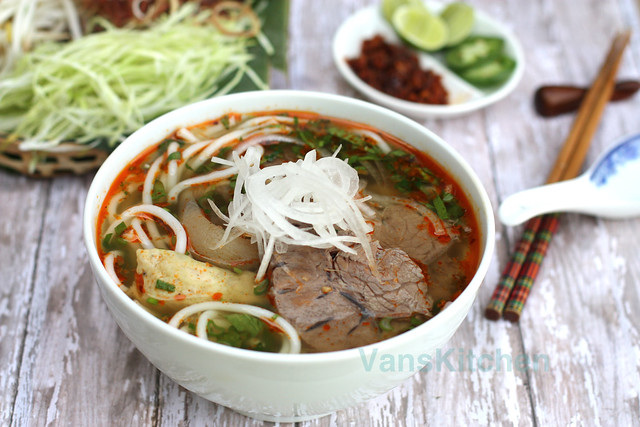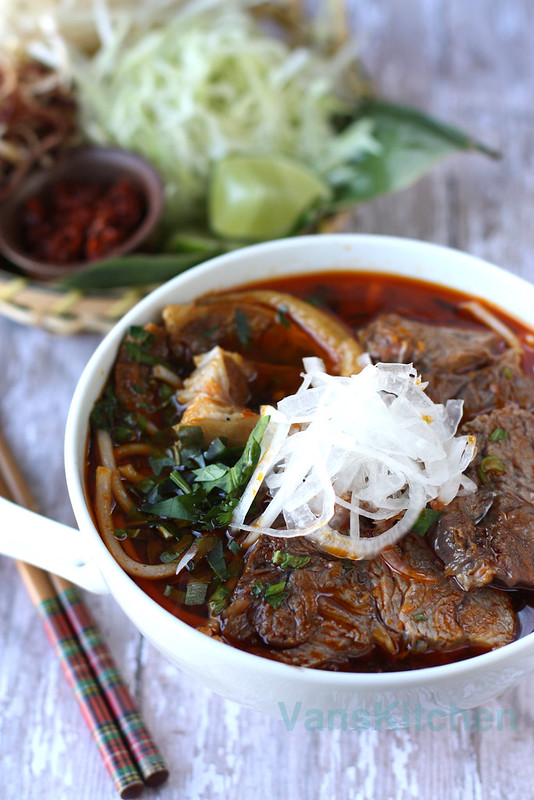
When it comes to Vietnamese noodles, Phở is the most popular. But if you love spicy food, Bún Bò Huế is a must try! Literally, the name "Bún Bò Huế" means "Huế-style beef noodle". Huế is the former capital of Vietnam, located in the center of the country. One distinguishing trait of Huế cuisine is that it is often very spicy.
You can order Bún Bò Huế at just about any food vendor in Vietnam. It is one of the most popular dishes there, served as breakfast, lunch, or even dinner. You can adjust the spiciness to taste when you eat it. It's very tasty, with a hint of zesty lemon flavor and a nice lemongrass aroma.
You can order Bún Bò Huế at just about any food vendor in Vietnam. It is one of the most popular dishes there, served as breakfast, lunch, or even dinner. You can adjust the spiciness to taste when you eat it. It's very tasty, with a hint of zesty lemon flavor and a nice lemongrass aroma.
Ingredients:
Stock:
1.5 lbs (680 g) beef bones
1.5 lbs (680 g) pork bones
2 lbs (900 g) beef shank
1 lb (450 g) sliced pork hocks
6 stalks of lemongrass, washed
1.5 lbs (680 g) beef bones
1.5 lbs (680 g) pork bones
2 lbs (900 g) beef shank
1 lb (450 g) sliced pork hocks
6 stalks of lemongrass, washed
¼ pineapple, peeled
1 daikon, peeled, cut into thick rounds
1 large (or 2 medium) onion(s), cooked in microwave for 3 minutes
1 - 2 garlic cloves
½ tsp pepper
1 - 2 tbsp salt
0.70 oz (20 g) rock sugar
2 tbsp shrimp paste
Satế (spicy mix)
½ cup (50 g) minced shallot
½ cup (50 g) minced lemongrass
¼ cup (30 g) minced garlic
½ tbsp paprika
chili flakes (to taste)
1 tbsp annatto seed
½ tbsp sugar
½ tsp salt
½ cup oil
Toppings and other:
Fresh noodle (If using dried noodle, cook following to the instructions)
Vietnamese coriander (rau răm) (washed, finely chopped)
Sliced onion (soaked in cold water, rinse well)
Sliced cabbage (soaked in cold water, rinse well)
Sliced banana blossom (soaked in cold water mixed with lemon juice, rinse well)
Bean sprout (washed, rinse well)
Green onion (washed, finely chopped)
Cilantro (washed, finely chopped)
Vietnamese ham (optional)
8 quart stock pot
Instructions:
8 quart stock pot
Instructions:
Put the shrimp paste in a small saucepan. Then add 2 cups of boiling water. Set it on medium-high heat. Stir to dissolve. Bring to a boil and skim off the foam coming to the surface. Let it simmer for 5~10 minutes. Then remove from the oven and let it sit.
Clean the bones and meat: bring a large pot of water to a boil, and add the pork bones, beef bones, sliced ham hocks, and beef shank. When it starts to boil again, take them out. Rinse well with boiling water.
Wash the lemongrass and cut it short enough to put in the tea bags. Halve the big part. Pound with the meat tenderizer. Put in a tea bag along with garlic, and close it.
Put the bones in a large stock pot, with the lemongrass bags in between. Add the daikon, sliced ham hocks, onion and beef shank. Add rock sugar, salt and pepper. Then cover with water.
Bring to a boil, then reduce the heat to medium-low. Skim off the foam coming to the surface.
Put the bones in a large stock pot, with the lemongrass bags in between. Add the daikon, sliced ham hocks, onion and beef shank. Add rock sugar, salt and pepper. Then cover with water.
Bring to a boil, then reduce the heat to medium-low. Skim off the foam coming to the surface.
Make the sate:
Heat oil in a fry pan over medium heat until hot. Add the annatto seeds and cook. Stir constantly until it turns a deep amber color; about 2 minutes. Strain the oil into the chopped shallot bowl. Discard the seed. Then put the pan back on the range, and add the chopped shallot. Stir often, and cook until the shallot softens and begins to brown. Add garlic, stir and cook until it smells good. Add lemongrass, stir and cook. Add sugar and salt. Stir and cook for a few minutes. Taste, and add more if needed. Add paprika and chili flakes. Stir well, then remove from the range.
Reserve the sate in a small bowl for later use. Leave about 2 tablespoons in the pan. Add the stock to the pan. Stir, and bring it to a boil. Let it simmer for a few minutes. Then turn of the heat.
About 1 hour later, take the beef shank out of the pot stock, and place it in a small saucepan. Cover beef shank with the stock. Put the pineapple in the beef shank saucepan. The pineapple helps tenderize the shank faster, and adds a sweet flavor to the meat and the soup.
Take the pork hocks out as well. Put them in a bowl, cover, and keep them warm.
Add more boiling water to the stock pot, and continue simmering.
Pour only the clear water in the shrimp paste pot into the saucepan. Add the sate sauce. Set it on medium heat and bring to a boil. Let it simmer for 30 minutes. Then add the ham hocks, and continue simmering for 15 minutes more, or until the ham hocks and the shank reach the tenderness you like. It shouldn’t be too tender; if it’s still a little chewy, it’s perfect. Turn off the heat.
Back to the stock pot. After 3 - 4 hours simmering, remove all the vegetables, bones, and lemongrass bags.
Take the beef shank and ham hocks out of the saucepan. Cover, and keep them warm. Remove the pineapple. Then strain into the large stock pot.
About 1 hour later, take the beef shank out of the pot stock, and place it in a small saucepan. Cover beef shank with the stock. Put the pineapple in the beef shank saucepan. The pineapple helps tenderize the shank faster, and adds a sweet flavor to the meat and the soup.
Take the pork hocks out as well. Put them in a bowl, cover, and keep them warm.
Add more boiling water to the stock pot, and continue simmering.
Pour only the clear water in the shrimp paste pot into the saucepan. Add the sate sauce. Set it on medium heat and bring to a boil. Let it simmer for 30 minutes. Then add the ham hocks, and continue simmering for 15 minutes more, or until the ham hocks and the shank reach the tenderness you like. It shouldn’t be too tender; if it’s still a little chewy, it’s perfect. Turn off the heat.
Back to the stock pot. After 3 - 4 hours simmering, remove all the vegetables, bones, and lemongrass bags.
Take the beef shank and ham hocks out of the saucepan. Cover, and keep them warm. Remove the pineapple. Then strain into the large stock pot.
Taste, and add more salt if needed. Now the stock is done, and ready to serve.
Slice the beef shank.
Heat the noodles. Strain well. Add to the bowl with the meat of your choice. Top with green onion, cilantro, Vietnamese cilantro, and onion. Pour in the hot stock and serve right away.
Heat the noodles. Strain well. Add to the bowl with the meat of your choice. Top with green onion, cilantro, Vietnamese cilantro, and onion. Pour in the hot stock and serve right away.
Before serving, add sate, lemon juice, raw vegetables to your preference. Mix well and serve!
Want a bowl of less spicy beef noodle soup and more variety of meats including beef shank, ham hock, and Vietnamese ham? Here you go! Xin mời (*-*)

Itadakimasu!



I found you on foodgawker and I have been craving for bun bo hue! I wish I could find someone out here in WA that sold in! Thank you for sharing this recipe :)
ReplyDeleteThere's a few restaurants in Tacoma that do.
DeleteHi Yen, thanks for stopping by. Your blog is very lovely! I enjoy reading it!
ReplyDeletethanks for the awesome recipe! I will try it today. How many servings does it make?
ReplyDeleteI'm making this now along side my former Vietnamese exchange student!
ReplyDeleteHe says it is such a familiar smell and reminds him of home already. =) Looking forward to the smell of the shrimp paste to clear the air...for sure! Thank you for the wonderful recipe and images. : Holly Murrah and Alex Bui
A decent van procure administration can enable you to accomplish increasingly and spare cash as well. In any case, there are such huge numbers of van employ administrations accessible today that it is extremely difficult to choose the correct van for your necessities. Try not to stress, we will enable you to conquer this issue.Rv Dealer missouri
ReplyDelete